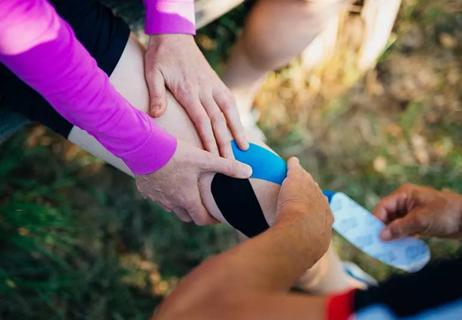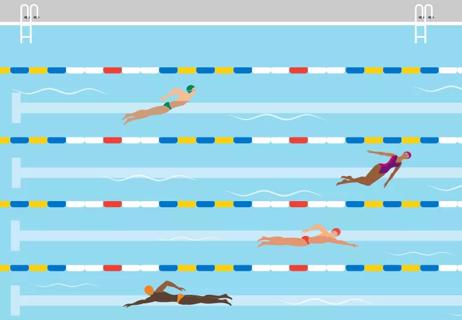Running doesn’t cause knee arthritis, but you can take steps to minimize cartilage damage

Running is one of the most affordable and convenient forms of exercise. But as you’re running (on a track at the gym, around your neighborhood, on a trail in the park, on a treadmill at home), you may wonder if you’re damaging your joints. All that impact and motion — will it lead to arthritis in your knees?
Cleveland Clinic is a non-profit academic medical center. Advertising on our site helps support our mission. We do not endorse non-Cleveland Clinic products or services. Policy
Not exactly.
“Running is certainly a load-bearing sport that impacts your body. But it’s a bit of a myth that it’s bad for your joints. There’s little evidence that running causes knee arthritis,” says sports medicine physician Anne Rex, DO.
Dr. Rex says running isn’t inherently bad for your knees — but it does affect them. She explains and offers tips for protecting your joints.
“Running causes changes to the cartilage and fluids in your knees,” says Dr. Rex. “But these changes are temporary. Cartilage can recover from those changes in between runs, and your body adapts to running over time.”
Bottom line: Running does not cause arthritis, and when you rest, your body — and your knees — recover from the effects of running. A recent study backs this up. In a large survey of marathon runners, researchers found that running more did not raise their risk of arthritis.
Running may even lower your risk of arthritis. As your knees compress when you run, more fluid travels to your joints to keep them lubricated. That means running may benefit your joints (in addition to improving your health).
Dr. Rex emphasizes the many benefits of running. “Running is great cardiovascular exercise. It’s convenient because you don’t need any equipment except a good pair of running shoes. You can open your front door and just go.”
But where you run can make a difference in your joint health. Dr. Rex discusses the potential benefits and risks of different running terrains.
“The type of surface you run on does matter because it changes the impact on your body,” notes Dr. Rex.
Think about bouncing a golf ball on different surfaces. The ball bounces differently depending on how hard the surface is. The same is true for your joints. The harder the surface, the more impact on your joints. Softer terrain means less impact.
A cushy woodland trail might seem best but has potential problems. Although softer, cushioned terrain, like grass or dirt trails, offers a gentler run that reduces impact, you need to be careful of uneven ground, slippery spots and objects you could trip over.
“We know that running-related injuries increase the risk of arthritis and joint damage,” she adds.
No, a treadmill isn’t bad for your knees. A treadmill is pretty easy on your joints because it’s flat, cushioned and free of obstacles.
“A treadmill can be great because you can run when the weather is bad or you don’t have access to a good outdoor route,” says Dr. Rex. “You can also control your pace and incline. But treadmills can be boring because there’s no change of scenery.”
She also cautions that if you’re training for a race, a treadmill isn’t a good choice. It’s best to train on the surface you’ll be racing on so your body can get used to it.
“Asphalt and concrete are solid and predictable. And these surfaces are everywhere, so they’re convenient,” says Dr. Rex. “But they’re very hard, which means more impact on your joints and possible injury due to those forces.”
She advises building more rest time between runs on very hard surfaces, allowing your knee cartilage to recover. “Someone who’s younger may be able to run consecutive days on concrete and not feel pain,” she continues. “But someone who’s older or has arthritis may find they need more rest days.”
“It really depends on you and the condition of your joints and body,” she clarifies. Running every day isn’t bad if your joints are healthy and you’re not trying to push through injuries. Always listen to your body rather than forcing yourself to stick to a strict running schedule.
Whether you’re training for a marathon or just getting started with running, take steps to give your knees some extra love.
Dr. Rex suggests six tips:
Running shoes are the most important piece of equipment for protecting your bones and joints. Your shoes act as shock absorbers for your body, but they wear out over time and lose their ability to absorb the impact of running.
“I usually tell people to replace their running shoes every 300 to 500 miles,” she says. “It’s also important to pick the right type of shoe. I recommend going to a running specialty store to get expert help.”
“Runners with arthritis require a longer recovery time to allow for knee cartilage recovery,” Dr. Rex states. So, if you already have arthritis and you’re not taking enough rest time between runs, you could be setting yourself up for more joint pain and damage.
Even if you’re in great condition, uninjured and free of arthritis, rest days help prevent problems down the road. Also, make sure to get plenty of sleep — that’s when your body makes repairs.
“For people with knee arthritis, I recommend trying some lightweight knee braces,” says Dr. Rex. “Braces may allow you to tolerate more running and even decrease the time needed to recover between runs.”
A sports medicine physician or physical therapist can help you find the right type of knee brace.
To help avoid injuries, don’t increase your mileage or intensity too quickly. Dr. Rex recommends limiting distance and duration increases to no more than 10% per week.
She also cautions against transitioning from treadmill to outdoor running too quickly. Go slowly and give your body time to adjust to different surfaces.
“You need to give your body the right nutrition to perform exercise such as running,” emphasizes Dr. Rex. “If you’re a serious runner, I highly recommend working with a sports nutritionist to make sure you’re getting enough calories and nutrients to help your body and joints recover.”
Working on your flexibility and strength can help prevent injuries. But if you do get injured, don’t just rest.
“Ideally, you should be working with a sports medicine specialist to correct whatever caused the injury,” says Dr. Rex. “That may mean correcting a muscle weakness, reducing muscle tightness or working on your form.”
She also recommends cross-training to balance out your running routine. “Try strength training, yoga or other activities on your rest days.” These activities may also help you reduce your risk of arthritis. And try exercises and stretches to ease knee pain (runner’s knee).
Take steps to prevent injuries and avoid falls. And care for your body when you’re not running. This way, you’ll be able to keep logging miles for years to come.
Learn more about our editorial process.

Sea lice aren’t really lice, but these tiny creatures can trigger an unpleasant allergic reaction

A type of high-intensity interval training, fitness boxing can challenge your body and mind

With a little precaution, you can prevent injuries and stay in this good-for-you game

Elastic therapeutic tape can provide extra support, but it can’t improve your stats

A lower-impact way to keep your heart strong and your mind sharp — and it’s so relaxing!

Adjust your bike seat, wear breathable clothing and don’t pop or pick!

The supplement can boost endurance and offer other benefits, including for sexual health

Despite unhealthy side effects, 40% of adult Americans still pee in pools

Your metabolism may torch 1,300 to 2,000 calories daily with no activity

A gentle touch in all the right places may help drain your sinuses